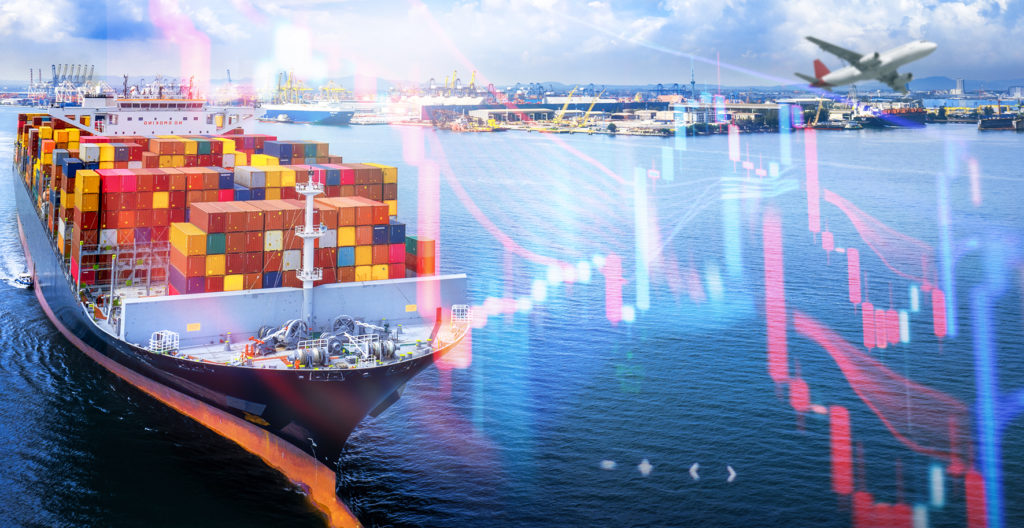lobal supply chains are still dealing with a turbulent and difficult operating environment. A softening in the demand for imports is expected for major economies in the coming months. Spending capacities in Europe and in the U.S. have weakened. In China, strict COVID restrictions spanning the country’s key ports continue to have a ripple effect on global supply chains. Conflicts involving cargo workers are adding to market uncertainty. Recent news headlines report companies across industries bracing for a potential economic downturn through workforce reductions or hiring freezes. The growth projection by the World Trade Organization supports this outlook, with world merchandise trade volumes expected to lower from 3.5% in 2022 to 1.0% in 2023.
Join the conversation with Shipco’s Group CEO, Christian Mogelvang, Global COO, Morten Bach, and COO – Global Airfreight, Kim Ekstroem, as they share insights on market developments and talk about their expectations for the coming year.
Christian Mogelvang
Group CEO

A silver lining from the volume downturn is that ocean carrier sailing reliability has improved marginally, as has the availability of equipment and slots on vessels. This has taken much of the urgency out of the logistics of moving ocean freight.
We are firm believers that the LCL business model will play a significant role in helping our forwarder customers in ´right-sizing´ the needs to shippers and consignees during this period. During the 2008-2009 recession, we saw an increase in LCL shipments in the market because the LCL option is a cost-effective way of shipping cargo overseas.
The return of shipment sizes to pre-pandemic levels is having a positive effect on our operations, speeding the flow of freight. With improvements in our gateway operations, we have seen faster throughput in the CFS’ and less delay times at the ports. As the clear market leader of LCL and having grown the weekly number of CFS/CFS direct services globally to over 2750 services, we are ready to handle every scenario for LCL, gateway or direct.
There are some remaining pockets of congestion, so things are still not to where they need to be. However, we are in a much better position to plan and operate against timetables. Our continued focus on mitigating risks and building resilience in our operations is also helping to make our services particularly valuable and highly effective for our customers.
Ultimately, we have come through this supply chain challenge stronger. The operating efficiencies we’ve gained during the peak will continue to be a huge benefit to us and for all our customers as volumes normalize in the near future.
Technology remains an important component in our playbook. Our connected platform and eBusiness tools on shipco.com are driving value for our forwarder customers, especially as they look to increase efficiencies, while lowering operating costs during this period of uncertainty.
Looking ahead, we will continue to adapt to the realities of the current business environment. We remain confident in delivering products, solutions and services to our customers that will exceed their expectations.

Morten Bach
Global COO
2022 has been a tumultuous year overall. The market which went up so fast, had to come down. It seems we have now arrived at that point as high inflation and higher mortgage rates have lowered consumer confidence and spending. This has started to have an impact on global shipping volumes.
Admittedly, the speed in which rate levels dropped from Asia was unexpected. Rate levels seem to have fallen off a cliff with drastic reductions from one month to the next, and it has only continued. Subsequently, some of the reductions seen on ocean freight are being mitigated by continual cost increases from trucking, warehouse and rail. It can be difficult at times to explain this to clients when the predominant conversation in our industry is about rate levels dropping.
Our number one priority is clear and consistent. We keep our forwarder customers competitive on rates, helping them retain existing business and close on new opportunities. We are tuned-in to daily rate changes in markets around the world and have the needed resources in our offices and global resource center committed to managing the rate shifts.
As we head toward 2023, this question is often asked: “How is the market moving?” To that, I say it can’t get much lower than it is right now. However, there is a debate and general concern as to when the markets will recover.
Volumes leading up to Chinese Lunar New Year are not expected to be at the usual levels. Generally, we expect there will be a mentality shift to move shipments out quickly. Cargo is likely already sold and therefore needed at its destination by the time it is ready to ship from origin.
As to when market growth is expected, the IMF projects global growth in 2023 to fall between 2-2.7% and for 2024, it would be 3.2%. Optimists are hedging volumes to increase 3-4% in 2023 but it could be as low 1-2%, – if the IMF´s lowest prediction holds true.
Meanwhile, the global carrier fleet is expected to grow 7-8% in 2023. However, capacity supply is expected to be reduced by 10% due to slower sailing speed and various blank and schedule changes being implemented. Although, lower congestion will off-set that decrease by the same percentage.
Let´s get ready for an interesting 2023! As Your Global Solution, we are committed to helping you navigate this competitive environment via our extensive coverage and dedicated team members globally.
Kim Ekstroem
COO – Global Airfreight

In just a few short months, the life of an air freight forwarder has changed like night and day. “Everything takes three times as long as it used to” was an often-heard phrase during the pandemic. Finding a trucker, double checking capacity and rates, truckers sitting in lines for hours if not half days, flight cancelations and more. Everything took forever. But the hard and tedious work came with a reward, in the sense that most forwarders experienced above pre-pandemic profits.
While everybody has been holding their breath hoping for a peak, it is now evident that this is not happening. The tables have turned. Air cargo tonnage is dropping, up to -17% year-on-year in November alone, capacity is increasing, and rates are going South. It is much easier to get space, and the fight over what is left of the pie will be fierce, and that will impact profitability. The shipments are still there, they are just smaller and less profitable.
The down market is being accompanied by lay-offs, and beginning next year, we will find ourselves being forced to do more with much less.
Our on-line platform Air2Z was introduced in the beginning of 2020, which unfortunately coincided with the onset of the COVID-19 pandemic. With airlines grounded, there were no schedules, rates were suspended, and airports became clogged. However, we’ve turned a corner and are now seeing a positive effect. Rates and schedules are predictable, and many of our forwarder customers are simply too busy to call or even mail us for a rate or a booking.
Using Air2Z, forwarder customers can instantaneously look up pick up costs, airfreight rate and schedules. They can quote their customer in a matter of seconds, book the shipment and view cargo and document images on-line. Shipments can also be tracked and traced, and it is all done in the same place.
In conclusion, we are better positioned now, more than ever, to confront market uncertainty and to prove the foundational strength of our business. We appreciate your continued support!




